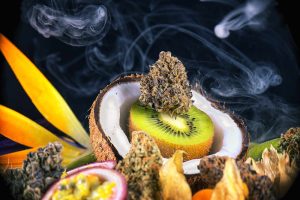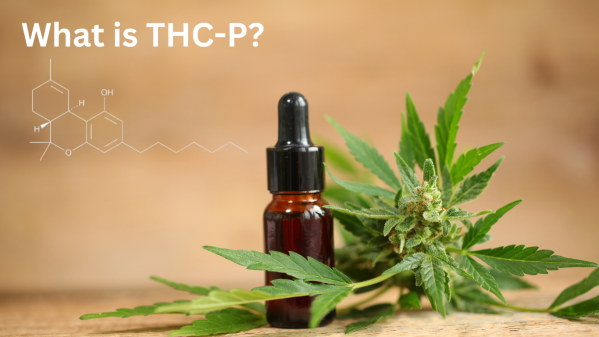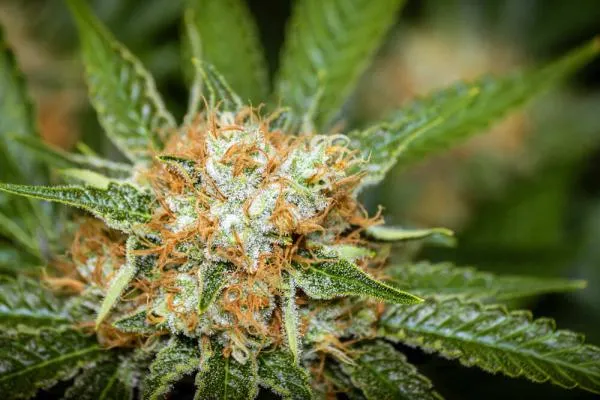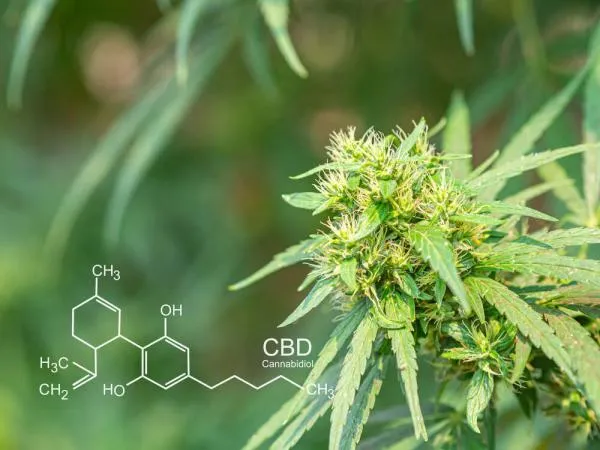While the knowledge base of your everyday stoner is light years ahead of what it was, say, a decade or so ago, the industry (and the research into cannabis) is moving at such an unbelievably fast rate that keeping up it all can feel like a full-time job.
In this fresh era of cannabis legalization, we have seen a huge focus put on not only the cannabinoid profile, but also the percentages of each of these compounds in each particular strain. And although these are important metrics, they are anything but the be-all-and-end-all.
Recent research into everybody's favorite plant is slowly uncovering some closely guarded secrets, chief among them being the importance that terpenes can and do play in both the aroma and effect of different cultivars.
- What are terpenes, and where do they come from?
- What do terpenes do in weed?
- Cannabis Terpene Chart
- Do terpenes affect the 'high'?
- What are the main terpenes found in cannabis?
- What is the difference between terpenes and cannabinoids?
- Are there any negative side effects of terpenes?
- Do terpenes have any medical benefits?
- Terpenes FAQ
What are terpenes, and where do they come from?
First up, let's get straight to the point.
Terpenes are aromatic organic compounds that are found in a huge variety of plants, not only cannabis. They're responsible for producing the delicious, dank, spicy, fruity, and herbal fragrances and flavors, and even some of the coloration in both cannabis and many other plant species.
They are produced by the same resin glands that produce cannabinoids like THC and CBD, meaning that they show up in different ratios depending on the strain you have. Furthermore, they are found in the largest quantities in the trichomes covering the buds, but are also present in the leaves, stems, and even the roots of the plant.
What do terpenes do in weed?
Up until quite recently, the general consensus was that the only measurable role that terpenes play was directly affecting the smell and taste of weed, and as a barrier of protection for the plant. But it turns out that their effects could be much more far-reaching than this, with various studies now linking them to a variety of potential therapeutic benefits.
On top of possibly offering their own unique set of medicinal qualities, they may actually modulate the effects of the cannabinoids that are present in each specific cultivar profile. The “Entourage Effect” is a theory that was first proposed back in 1998, and suggests that the combination of cannabinoids and terpenes work together to create a unique experience that each strain can offer. The hypothesis is that the resulting effects can, in some cases, be more than the sum of their parts.
Terpenes also offer protective qualities to the plant itself. In nature, they can act as a natural insect repellent and/or attractant, depending on the species of plant. The fragrances they produce can entice pollinating insects, or deter harmful pests and predators from coming close. The latter is the case when it comes to the sticky-icky, as terpenes like Myrcene, Limonene, and Pinene can drive away or confuse any unwanted visitors.
They also help protect the plants from the harsh weather conditions that many wild landrace strains battle against. As one of the main constituents of trichomes, terpenes help to shield the plant from UV radiation, extreme temperatures, and driving rain.
Cannabis Terpene Chart
To give you a clear visual representation of the most common terpenes found in cannabis plants below is a terpene chart covering the effects, aroma, associated smell and medical benefits of each of the terpenes.
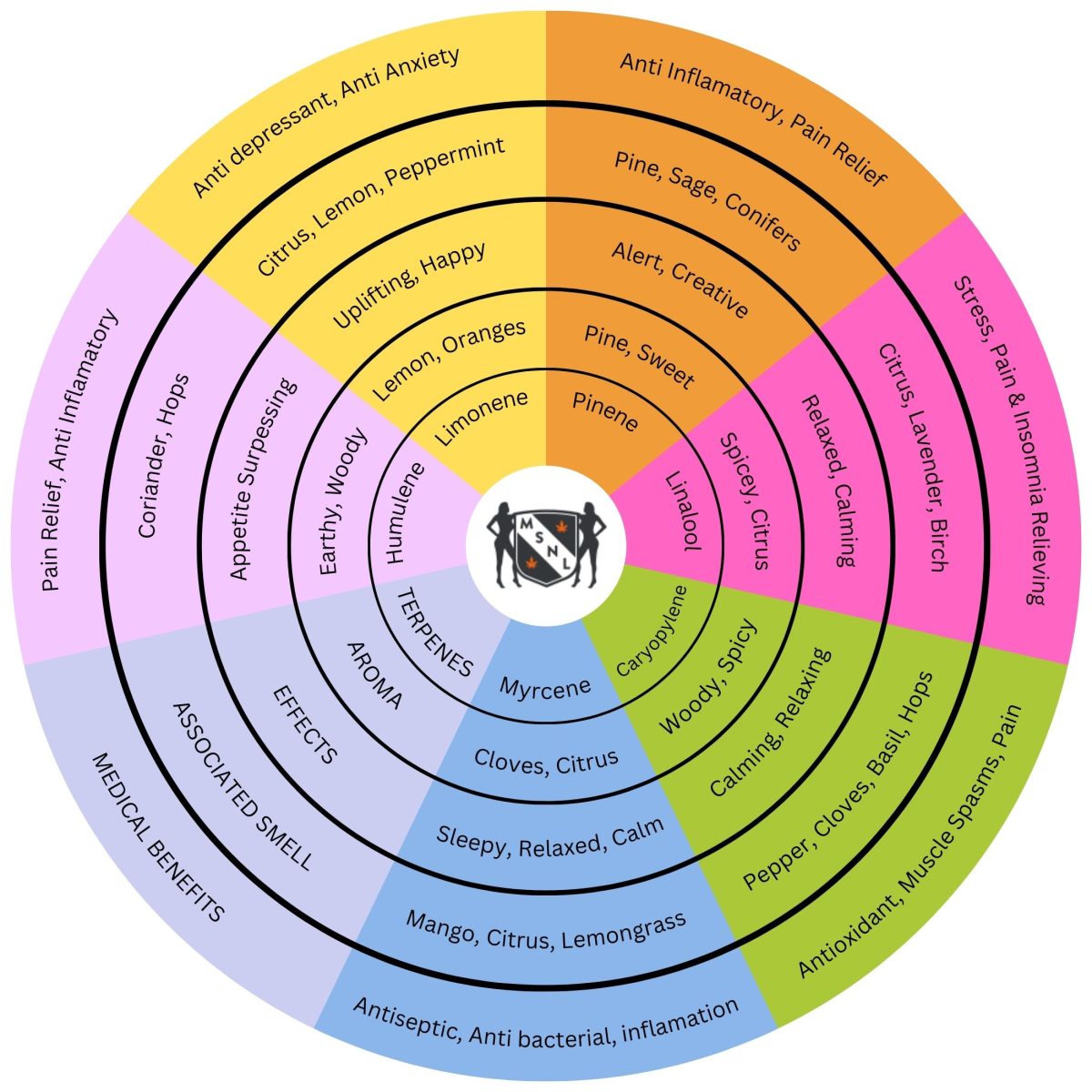
Do terpenes affect the 'high'?
Very possibly. While the “entourage effect” is still just a theory, the research that has followed certainly seems to back the idea up. While cannabinoids like CBD and THC are credited with most of the effects, certain clinical studies have shown that terpenes may also influence how these compounds impact us.
Although they are not intoxicating on their own, they are classed as psychoactive compounds. This means that although you cannot just bomb a bunch of terps and shoot off into the shadow realms, they do have the ability to potentially their importance in altering the effects that both THC and CBD offer cannot be overlooked.
Different terpenes appear to modulate the effects of weed in different ways, depending on the combination present in a particular strain.
For example, Limonene has been credited with offering a more uplifting and energizing state of mind. Myrcene dominant cultivars have been shown to introduce a feeling of relaxation and serenity, as have Pinene dominant strains.
What are the main terpenes found in cannabis?
| Terpene Name | Associated Smells | Description | Strains |
|---|---|---|---|
| Myrcene | Earthy | Most abundant in cannabis, contributes to the couch-lock effect of indica strains, useful as sleep aids or muscle relaxants. | White Widow, Bubba Kush |
| Beta-caryophyllene | Spicy | Acts as an anti-inflammatory, promotes healthy digestion, enhances wound healing, binds directly to CB-2 receptors. | Cookies Strains Gorilla Glue #4, OG Kush |
| Limonene | Citrus | Imparts uplifting effects, excellent for daytime productivity, may help in treating depression and anxiety. | Wedding Cake Do-Si-Do Super Lemon Haze |
| Linalool | Floral | Known as the “spa terpene” for its relaxing and calming properties, may reduce muscle spasms, relieve pain, and treat anxiety. | LA Confidential Master Kush Do Si Dos |
| Pinene | Piney | Reduces inflammation, aids memory, acts as an antimicrobial agent, opens the respiratory passageways. | Gushers Blue Dream Fruity Pebbles |
| Humulene | Earthy | Useful for inflammation and weight control. | Headband OG Sour Diesel White Widow |
| Terpinolene | Fresh | May help inhibit tumor growth and can have a positive effect on cardiovascular disease. | Jack Herer Durban Poison |
| Alpha-bisabolol | Floral | Has potent antibacterial and antioxidant properties, may help reduce skin inflammation. | Purple Thai Gelato Tangerine Dream |
| Eucalyptol | Minty | Has potent antibacterial, antifungal, and insect-repelling properties, may help to lower blood pressure. | London Pound Cake GMO Cookies |
| Geraniol | Floral | May have antimicrobial, antioxidant, antiviral, and neuroprotective properties, excellent mosquito repellent. | Purple Punch Headband OG |
| Terpineol | Floral | Studied for its antioxidant, anti-anxiety, anti-malarial, and sedative effects. | Skywalker OG Jack Herer |
| Farnesene | Tart, fruity | Has neuroprotective properties and may help prevent certain types of cancer. | White Rhino Cherry Pie |
| Borneol | Minty | Imparts pain-relieving and anti-inflammatory effects. | OG Kush Amnesia Haze |
| Ocimene | Sweet, herbal | Has antioxidant, antimicrobial, and cancer-fighting properties. | Jack Herer Amnesia |
| Nerolidol | Woody | Has potent antifungal, antioxidant, antimicrobial, and anti-inflammatory properties. | Chemdawg Skunk #1 |
| Guaiol | Piney | May induce cell apoptosis in lung tumors. | Fruity Pebbles |
| Valencene | Citrusy | Renowned for its ability to repel insects, reduce inflammation, and fight skin cancer. | Tangie Agent Orange |
| Delta-3 Carene | Piney, lemony, musky | May help with neuropathic conditions like fibromyalgia and Alzheimer’s disease, may help heal broken bones. | Bruce Banner Sour Grape |
| Phytol | Floral | May be useful for pain-relief, reducing stress, and promoting healthy sleep patterns. | Cheese OG Kush |
| Sabinene | Earthy, spicy, peppery | May help aid digestion, relieve arthritis, calm skin conditions, and prevent muscle atrophy. | Super Lemon Haze Sour Diesel |
| Phellandrene | Minty, citrusy | May be useful for digestive problems, depression, and neuropathic pain. | Trainwreck Jack Herer |
| Fenchol | Woody, citrusy | Fenchol, found in fennel, has a woody, citrus aroma and is often used in perfumes, contributing to the flavor profile. | OG Kush Banana Kush |
| Menthol | Minty | May help kill bacteria and reduce inflammation. | ChemDog Gelato |
| Terpinene | Earthy | Terpinene, with its earthy, pine-like aroma, may exhibit potential antitumor properties and contributes to the flavor of cannabis. | Bruce Banner Sour Diesel |
What is the difference between terpenes and cannabinoids?
Terps and cannabinoids are both organic compounds produced by weed, and both have the potential to interact with our bodies, but that's where the similarities end.
While terps are present in a vast array of both plants and animals, cannabinoids are less commonly found elsewhere. They are also unique in the sense that cannabinoids produced by weed can directly interact with our endocannabinoid systems, thus influencing a huge variety of physiological processes. Terps, for the most part, interact with our sensory receptors and olfactory systems to affect our mood, sense of smell, and overall experience.
And although there is evidence to suggest that some terps may interact with the endocannabinoid system (ECS), they are not officially classed as cannabinoids. This is why it's important to understand that each component of weed has its own unique set of effects, and that these can be experienced both alone and in combination with other compounds.
One terpene that has been shown to directly interface with the ECS is Beta-Caryophyllene, which is present in a bunch of cannabis strains, and binds to the CB2 receptor. We will delve into this specific interaction later in the article.
Are there any negative side effects of terpenes?
As with most ingestible compounds, terpenes do come with the possibility of certain negative side effects, but the good news is that at the concentrations found in weed, these are not something to be overly concerned about. Generally speaking, to feel any of these downsides, you would have to consume massive quantities of terps.
With that said, the main thing to look out for is allergic reactions, as some people may be sensitive to certain terpenes when inhaled. You may feel an itching sensation in the eyes or skin, or a sore throat. Some people also report feeling headaches after consuming terpenes, add this could also be due to sensitivity. On the plus side, these types of reactions are rare and usually quite mild.
If you do find that you are particularly sensitive to certain smells or flavors, it may be best to look for strains that have low terpenes concentrations.
Do terpenes have any medical benefits?
Now we get to the juicy bit.
While the research is still ongoing, there are now various studies that have suggested the potential therapeutic benefits of terpenes. Although they are not as widely celebrated as cannabinoids, what we do know is that they may be integral to the curative properties of any individual cultivar and that their effects may be enhanced when used in combination with other compounds.
Let's take a look at a few key examples.
Mood enhancement
There is a fair bit of clinical research out there that points to the possibility of terpenes being effective in mood modulation.
This paper, titled “Linalool as a Therapeutic and Medicinal Tool in Depression Treatment: A Review”, concludes that linalool has been found to have potential antidepressant effects by acting on various targets such as the dopaminergic and neuroendocrine systems, inflammatory process, oxidative stress, and neurotrophic factors, and that it may be a promising bioactive compound in the therapeutic arsenal for depression treatment.
Limonene also looks to be a promising mood-elevating option. This study showed that, in mice, limonene was able to reduce anxiety markers, potentially through GABA release augmentation. GABA is an important neurotransmitter that is known for increasing feelings of calmness and is thought to be a major player in controlling feelings of anxiety, stress, and fear.
β-caryophyllene is another interesting terpene when it comes to mood regulation. As mentioned above, it is one of the few terpenes that has been shown to directly interact with the ECS (the CB2 receptor specifically), and it is through these interactions that it may be able to regulate mood. This study look into the stress and depressive response in animals, and found that beta-caryophyllene was effective at reducing “chronic stress-induced despair behaviors”.
Antiviral properties
The first piece of research that jumps out is this clinical trial. It focuses on the possible effectiveness of Myrtol in reducing acute bronchitis. Myrtol is made up of three main terpenes: alpha-pinene, limonene, and cineole. It found that these three terps potentially reduced the signs and symptoms of acute bronchitis, reporting the treatment was “well tolerated and evidently superior in terms of efficacy, resulting in a more rapid and more complete recovery than when compared to a placebo”.
Antimicrobial properties
The antimicrobial action of terpenes is one of the more interesting uses for these compounds as a whole. A recent paper published by the National Library of Medicine reports that “Although the antibacterial mode of action of terpenes remains largely unknown, most terpenoids are able to inhibit two crucial processes which are essential to microbial survival, this includes oxygen uptake and oxidative phosphorylation”.
This essentially means that terpenes are inherently antimicrobial, and that they may be effective in the treatment of a range of infections.
The same paper states the potential importance that terpenes may hold in the fight against antibiotic resistance, and concludes “terpenes and their derivatives, which are natural secondary metabolites found in plants, have potent antimicrobial activity against drug-resistant pathogens such as bacteria and fungi. The specific mechanisms of each class of terpenes have been highlighted, and as a whole, terpenes provide a possible mitigation route for antimicrobial resistance (AMR) and navigating the dead end of the diminishing antibiotic pipeline"
Antidepressant properties
Terpineol has shown promise in offering antidepressant effects. This paper references a range of animal studies looking into the subject, and goes into detail on the potential pathways and mechanisms through which terpineol may help to reduce symptoms of depression, including the possibility that terpineol's antidepressant-like effects are mediated through the cannabinoid system and D2 dopamine receptor.
Linalool has also been shown to have potentially depressive fighting qualities. This National Institute of Health paper, while focusing on other therapeutic aspects of the terpenes, also showed that linalool may provide antidepressant effects by NMDA receptor blockade and inhibiting the reuptake of serotonin.
Anxiety Relief
Anxiety control or reduction through the use of terpenes has been a long-standing area of focus in the medical community. Aromatherapy, which employs the use of essential oils (which are made of mostly terpenes) has, for centuries, been used to improve mood and decrease anxiety. We are now seeing the science catch up, and research being conducted to show the efficacy of using terpenes for anxiety relief.
Pinene and linalool show great promise in this area, with one review paper showing that the combination of these two terpenes may be effective in controlling the symptoms of not only aggravated anxiety levels, but also inflammatory and neuropathic pain, cognitive impairment, insomnia, and depression.
Pain Relief
Recent research coming out of the University of Arizona Health Sciences department has boosted the “entourage effect” theory, by showing that four cannabis terpenes - alpha-humulene, geraniol, linalool, and beta-pinene – all emulate the effects of cannabinoids, including a drop in pain sensations. They also showed that this effect was amplified in the presence of CBD and THC.
Terpenes FAQ
Are terpenes bad for you?
While terpenes are generally considered to be extremely safe, they can cause some negative side effects when applied or ingested in large doses. The dosage sizing of terpenes in cannabis is not usually thought of as a large amount, so, you don't usually need to worry.
Some people display an allergic reaction to some types of terpenes, and as with anything else, too much of a good thing can be harmful.
If you experience any negative reactions or symptoms when using terpenes, stop use and consult a doctor.
Are terpenes safe to vape?
Yes, they are. Terpenes are a natural constituent of many plants, and therefore they have been found to be safe for consumption in humans. So long as you use a reputable terpene supplier (as you would with any other vape product) there is zero need for concern.
It's always best to check with a professional before using any new products, but this is especially true when it comes to vaping.
Is CBD a terpene?
No, CBD is not a terpene. While both are components of the cannabis plant, they have very different properties and effects. Terpenes are aromatic compounds that give cannabis plants their flavor and smell, while CBD is a cannabinoid with numerous potential therapeutic benefits, while also be totally non-intoxicating.
CBD does work together with terpenes to create the “entourage effect”, where all of the cannabis compounds work together to produce a greater benefit than they would on their own. To take advantage of this effect try growing cannabis seeds that are high CBD but also full of flavor such as Mandarin CBD.
Why are terpenes important in CBD?
As we just mentioned, while both cannabinoids (CBD, THC, CBN, CBG) and terpenes may offer certain therapeutic effects on their own, this effect is greater when combined with the other compounds. This is known as the “entourage effect”.
Terpenes offer a wide range of potential benefits, from reducing anxiety to providing anti-inflammatory properties. They can also help to modulate the effects of cannabinoids, such as CBD and THC.
Do terpenes reduce anxiety?
Certain terpenes have been shown to offer possible antianxiety and antidepressant effects. Pinene and linalool are two terpenes that have been studied for their potential to reduce anxiety, and research has suggested that they may be effective in controlling the symptoms of aggravated anxiety levels, as well as inflammatory and neuropathic pain, cognitive impairment, insomnia, and depression.
What terpene is best for depression?
Terpineol has shown promise in offering antidepressant effects, as well as the potential to reduce symptoms of depression. Linalool has also been shown to have potentially depressive fighting qualities, and may provide antidepressant effects through a few possible actions, including NMDA receptor blockade and inhibiting the reuptake of serotonin.
Which terpene makes you happy?
Happy is a pretty subjective term, but pinene and linalool have both been studied for their potential to reduce anxiety. Limonene has also been proposed to have uplifting effects, and may be useful for reducing stress and anxiety levels. Of course, everyone is different and experiences the effects of terpenes differently. It's important to experiment and find what works best for you.
Can terpenes be addictive?
Nope, only intoxicating substances are considered to be addictive. Terpenes are safe and natural compounds found in many plants, they do not have any intoxicating effects and therefore cannot be considered to be addictive. That being said, they should still be used responsibly and according to directions.
Do terpenes show up on drug tests?
No, terpenes will not show up on a drug test. Most drug tests look for either the presence of cannabinoids or the enzymes that the body produces when it reacts to cannabinoids. Terpenes are not psychoactive, and therefore will not show up on any drug test.
References:
Sommano, S.R., Chittasupho, C., Ruksiriwanich, W. and Jantrawut, P. (2020). The Cannabis Terpenes. Molecules, [online] 25(24), p.5792. doi:https://doi.org/10.3390/molecules25245792.
Aly, E., Khajah, M.A. and Masocha, W. (2019). β-Caryophyllene, a CB2-Receptor-Selective Phytocannabinoid, Suppresses Mechanical Allodynia in a Mouse Model of Antiretroviral-Induced Neuropathic Pain. Molecules, 25(1), p.106. doi:https://doi.org/10.3390/molecules25010106.
dos Santos, É.R.Q., Maia, J.G.S., Fontes-Júnior, E.A. and do Socorro Ferraz Maia, C. (2022). Linalool as a Therapeutic and Medicinal Tool in Depression Treatment: A Review. Current Neuropharmacology, 20(6), pp.1073–1092. doi:https://doi.org/10.2174/1570159x19666210920094504.
Ferber, S.G., Namdar, D., Hen-Shoval, D., Eger, G., Koltai, H., Shoval, G., Shbiro, L. and Weller, A. (2020). The ‘Entourage Effect’: Terpenes Coupled with Cannabinoids for the Treatment of Mood Disorders and Anxiety Disorders. Current Neuropharmacology, 18(2), pp.87–96. doi:https://doi.org/10.2174/1570159x17666190903103923.
Matthys, H., de Mey, C., Carls, C., Ryś, A., Geib, A. and Wittig, T. (2000). Efficacy and tolerability of myrtol standardized in acute bronchitis. A multi-centre, randomised, double-blind, placebo-controlled parallel group clinical trial vs. cefuroxime and ambroxol. Arzneimittel-Forschung, [online] 50(8), pp.700–711. doi:https://doi.org/10.1055/s-0031-1300276.
Song, Y., Seo, S., Lamichhane, S., Seo, J., Hong, J.T., Cha, H.J. and Yun, J. (2021). Limonene has anti-anxiety activity via adenosine A2A receptor-mediated regulation of dopaminergic and GABAergic neuronal function in the striatum. Phytomedicine: International Journal of Phytotherapy and Phytopharmacology, [online] 83, p.153474. doi:https://doi.org/10.1016/j.phymed.2021.153474.
Vieira, G., Cavalli, J., Gonçalves, E.C.D., Braga, S.F.P., Ferreira, R.S., Santos, A.R.S., Cola, M., Raposo, N.R.B., Capasso, R. and Dutra, R.C. (2020). Antidepressant-Like Effect of Terpineol in an Inflammatory Model of Depression: Involvement of the Cannabinoid System and D2 Dopamine Receptor. Biomolecules, [online] 10(5), p.792. doi:https://doi.org/10.3390/biom10050792.
